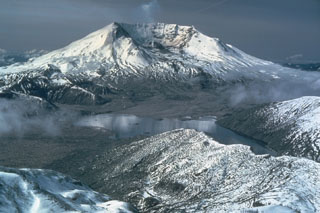Report on St. Helens (United States) — 9 February-15 February 2011
Smithsonian Institution / US Geological Survey
Weekly Volcanic Activity Report, 9 February-15 February 2011
Managing Editor: Sally Sennert.
Please cite this report as:
Global Volcanism Program, 2011. Report on St. Helens (United States) (Sennert, S, ed.). Weekly Volcanic Activity Report, 9 February-15 February 2011. Smithsonian Institution and US Geological Survey.
St. Helens
United States
46.2°N, 122.18°W; summit elev. 2549 m
All times are local (unless otherwise noted)
CVO reported that on 14 February a M 4.3 earthquake near Mount St. Helens, felt widely throughout SW Washington and NW Oregon, was followed over the next few hours by several aftershocks up to M 2.8. The three largest aftershocks were also felt. All of the earthquakes were located about 8 km N of the crater, near the Johnston Ridge Observatory, at depths of about 4-6 km. CVO also noted that a previous earthquake swarm had occurred in the same area on 29 January. The Volcano Alert Level remained at Normal and the Aviation Color Code remained at Green.
Geological Summary. Prior to 1980, Mount St. Helens was a conical volcano sometimes known as the Fujisan of America. During the 1980 eruption the upper 400 m of the summit was removed by slope failure, leaving a 2 x 3.5 km breached crater now partially filled by a lava dome. There have been nine major eruptive periods beginning about 40-50,000 years ago, and it has been the most active volcano in the Cascade Range during the Holocene. Prior to 2,200 years ago, tephra, lava domes, and pyroclastic flows were erupted, forming the older edifice, but few lava flows extended beyond the base of the volcano. The modern edifice consists of basaltic as well as andesitic and dacitic products from summit and flank vents. Eruptions in the 19th century originated from the Goat Rocks area on the N flank, and were witnessed by early settlers.
Source: US Geological Survey Cascades Volcano Observatory (CVO)

